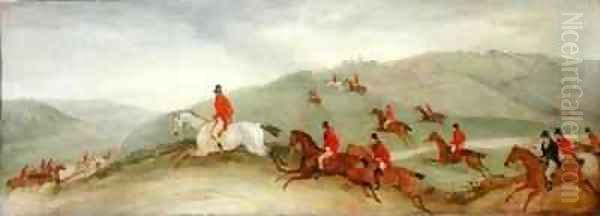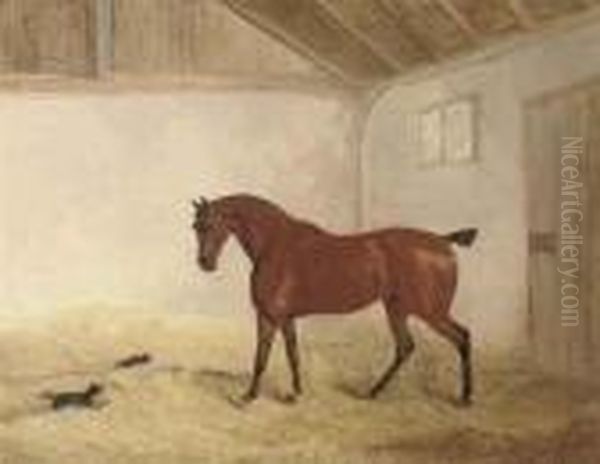Richard Barrett Davis stands as a notable figure within the rich tapestry of British art during the late Georgian and Victorian periods. Born in 1782 and passing away in 1854, his career spanned a time of significant change both in society and in the art world. He carved a distinct niche for himself primarily as a painter of animals, particularly horses, and as a chronicler of sporting life and landscapes, earning recognition that included royal patronage. Understanding his life and work requires placing him within the context of his time and distinguishing him from other individuals who shared his name.
Early Foundations and Artistic Training
Richard Barrett Davis entered the world in Watford, Hertfordshire, in 1782. His formative years included education at prestigious institutions: Eton College, known for educating the British elite, followed by formal art training at the Royal Academy Schools in London. Admission to the RA Schools was a significant step for any aspiring artist, placing Davis within the central institution of the British art establishment. Here, he would have received rigorous training in drawing, anatomy, and composition, following a curriculum that had nurtured generations of artists, including luminaries like J.M.W. Turner and John Constable, although their artistic paths would diverge significantly from Davis's own.
Davis's public career began relatively early. He first exhibited his work in 1802, likely at one of the major London venues such as the Royal Academy itself or the British Institution. This marked his entry into the competitive London art scene, where he would gradually build his reputation over the ensuing decades. His chosen specialisms – animals and sporting scenes – were already well-established and popular genres in British art, catering to the tastes of the landed gentry and aristocracy.
The Sporting Life: Style and Subject Matter

Davis dedicated much of his artistic output to the depiction of animals and the sporting pursuits associated with country life. Horse portraiture, hunting scenes, and depictions of other animals, both domestic and exotic, formed the core of his oeuvre. This focus placed him in a lineage of British artists renowned for their skill in animal painting, a tradition arguably reaching its zenith with George Stubbs in the previous century, and continuing through contemporaries and near-contemporaries like John Frederick Herring Sr., Ben Marshall, and Sawrey Gilpin.
His style, typical of the era, likely emphasized anatomical accuracy, particularly in his rendering of horses, combined with a keen observation of animal behaviour and movement. The landscapes in his sporting scenes served not just as backdrops but as integral parts of the narrative, depicting the specific environments where these activities took place. Victorian art often carried narrative or anecdotal weight, and sporting pictures frequently captured moments of action, camaraderie, or the relationship between humans, animals, and the land. Davis's work participated in this tradition, offering visual records of a way of life central to the identity of the British upper classes.
Notable Works and Themes
Several works are cited as representative of Richard Barrett Davis's output, showcasing his thematic concerns and artistic skills.
One significant painting is Sir Roger de Coverley and His Hounds A Sporting Portrait, dated to 1843. The title references a famous fictional character, Sir Roger de Coverley, created by Joseph Addison and Richard Steele for The Spectator magazine in the early 18th century. Sir Roger was conceived as the archetypal, benevolent, slightly eccentric Tory country squire. While the painting dates from over a century after the character's literary creation, its title suggests an attempt to evoke the enduring ideal of the country gentleman engaged in his traditional pursuits. It is unlikely to be a literal depiction of the fictional character but rather uses the name to signify a type, portraying a contemporary figure and his hounds in a classic sporting context. The specific details of the scene are not fully documented in readily available sources, but the title firmly places it within the genre of sporting portraiture.

Another intriguing work is Three ‘Liger’ Cubs Bred Between a Lion And A Tiger At The Royal Menagerie, painted significantly earlier, in 1824. This piece highlights a different facet of animal painting – the depiction of exotic or unusual creatures. The Royal Menagerie, housed at the Tower of London until the 1830s before forming the basis of London Zoo, was a popular attraction. The birth of hybrid animals like ligers (offspring of a male lion and a female tiger) would have been a subject of considerable public curiosity. Davis's painting captures this specific event, demonstrating his ability to render less familiar animal forms and reflecting a broader societal interest in natural history and the exotic. This interest was also catered to by artists like Sir Edwin Landseer, who famously painted lions and other animals, sometimes with anthropomorphic qualities.
A third named work, Foxhunting - Road Riders or Funkers, further cements Davis's reputation as a painter of the hunt. Foxhunting was a quintessential subject for British sporting artists, with families like the Alkens (Samuel Alken, Henry Thomas Alken) dedicating much of their careers to its depiction. The subtitle, "Road Riders or Funkers," hints at the social dynamics and perhaps the humour sometimes associated with the hunt, possibly distinguishing between enthusiastic participants and those who preferred to follow the chase from the comparative safety of the roads. Such works offered patrons detailed and often dramatic visualisations of their favoured pastime.
Professional Recognition and Royal Appointment
Davis achieved significant professional milestones during his career. In 1829, he became a member of the Society of British Artists (SBA), now known as the Royal Society of British Artists. The SBA had been founded in 1823 as an alternative exhibition venue to the Royal Academy, providing more opportunities for artists to show and sell their work. Membership signified peer recognition within the broader London art community.
A pinnacle of his career arrived in 1831 when he was appointed Animal Painter to King William IV. Royal appointments were highly prestigious, conferring status and often leading to important commissions. This appointment specifically acknowledged his expertise in animal portraiture and related subjects, placing him in the service of the monarch. While perhaps not as internationally renowned as court painters like Anthony van Dyck under Charles I or Franz Xaver Winterhalter under Queen Victoria, Davis's appointment underscored his standing as a leading practitioner in his field within Britain. It confirmed that his depictions of animals, particularly the horses so central to royal life and ceremony, met the highest standards of the time.
Context within Victorian Art
Richard Barrett Davis worked during a period of immense artistic diversity in Britain. While he focused on traditional genres, the broader art world saw the dramatic landscapes of J.M.W. Turner evolve into near abstraction, the detailed naturalism of John Constable influence landscape painting across Europe, and the rise of the Pre-Raphaelite Brotherhood (including artists like John Everett Millais, Dante Gabriel Rossetti, and William Holman Hunt) challenge academic conventions with their detailed, brightly coloured, and morally charged subjects.
Davis's art, however, remained largely within the established conventions of sporting and animal painting. This was a commercially viable and socially significant field, deeply connected to the patronage of the aristocracy and landed gentry who commissioned portraits of favourite horses, hounds, and records of successful hunts. His work provided skilled and faithful representations within this tradition, valued for its accuracy and its celebration of a particular lifestyle. He was a contemporary of other successful animal painters like John Frederick Herring Sr., known for his dynamic coaching and racing scenes, and the slightly younger, immensely popular Sir Edwin Landseer, whose dramatic and often sentimental depictions of animals captured the Victorian imagination.
Important Distinctions: Avoiding Confusion
It is critically important to distinguish Richard Barrett Davis, the painter (1782-1854), from other notable individuals named Richard Davis or Richard Barrett, particularly those mentioned in potentially confusing search results or summaries.
The painter should not be confused with Richard Davis, the highly acclaimed American jazz bassist and music educator (born 1930). This musician worked with figures like Eric Dolphy and Van Morrison, taught at the University of Wisconsin-Madison, was mentored by Walter Dyett (whose students also included Nat King Cole), and received prestigious awards like the NEA Jazz Masters fellowship, the Kranichsteiner Music Prize, and the Gaudeamus Award. These achievements belong solely to the musician, not the 19th-century British painter.
Similarly, anecdotes concerning humorous social interactions in university clubs, imitating actors backstage, inventing showers during wartime, experiences as a war correspondent involving arrests, extensive world travels with a wife, volunteering at food banks, fishing trips, or meeting Elvis Presley, likely pertain to other figures, possibly the well-known American writer and war correspondent Richard Harding Davis (1864-1916) or other individuals. These colourful life events are not documented as part of the painter Richard Barrett Davis's biography.
Furthermore, the painter must be distinguished from Richard Barrett, a contemporary British composer associated with the ensemble ELISION and known for complex musical works. Collaborations mentioned in relation to ELISION pertain to this composer.
Finally, any mention of a controversial figure named Richard Barrett associated with white supremacist ideologies, particularly one reported as murdered in Mississippi, refers to a completely different person and has absolutely no connection to the Victorian artist Richard Barrett Davis.
Maintaining these distinctions is crucial for an accurate understanding of the painter's life and work, which appears focused entirely on his artistic career within Britain during the late 18th and first half of the 19th century. Available records do not detail his marital status, specific students he may have taught, or documented collaborations with other painters of his era.
Legacy and Conclusion
Richard Barrett Davis occupies a solid, if not star-studded, place in the history of British art. His primary contribution lies in his skilled and consistent output within the popular genres of animal and sporting painting. He catered to the tastes of his time, providing patrons with accurate and engaging depictions of horses, hounds, and the activities of country life. His work reflects the enduring British fascination with equestrian subjects and field sports.
The royal appointment as Animal Painter to William IV serves as the clearest indicator of his contemporary standing. While perhaps overshadowed in art historical narratives by more revolutionary figures like Turner or the Pre-Raphaelites, Davis represents the competent and successful professional artist serving a specific market and tradition. His paintings, such as the depictions of the Sir Roger de Coverley theme, the exotic liger cubs, or the dynamics of the fox hunt, offer valuable visual documents of the interests and aesthetics of Victorian Britain. He remains a figure recognized by specialists in British sporting art, a testament to his skill in capturing the form and spirit of the animals he portrayed and the world they inhabited. His legacy is that of a dedicated and accomplished painter within a defined, yet significant, field of British artistic production.